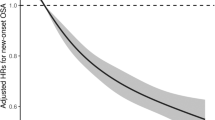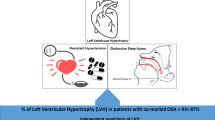Abstract
The interaction of advanced glycation end products (AGE) and their specific cell-surface receptor (RAGE) has an important role in the pathogenesis of cardiovascular disease and diabetic complications. Two isoforms of C-truncated RAGE, soluble RAGE (sRAGE) and endogenous secretory RAGE (esRAGE), may prevent activation of RAGE signaling by acting as decoys. This study investigated whether serum esRAGE and sRAGE levels are associated with blood pressure in nondiabetic patients with obstructive sleep apnea (OSA). Male nondiabetic patients (n=139) with OSA were enrolled. Serum esRAGE and sRAGE levels were examined using enzyme-linked immunosorbent assay. Three consecutive seated systolic blood pressure (SBP) and diastolic blood pressure (DBP) measurements were obtained at 5-min intervals in the morning. In univariate analysis, there was a significant correlation between serum esRAGE and SBP or DBP, but not between serum sRAGE and SBP or DBP. Multiple regression analysis showed that SBP was independently associated with waist circumference, HbA1c, minimum SaO2 and serum esRAGE, and that DBP was independently associated with low-density lipoprotein cholesterol, apnea–hypopnea index, serum AGE and body mass index, but not with serum esRAGE. These results indicated that serum esRAGE levels were inversely associated with blood pressure, especially SBP, in male nondiabetic patients with OSA. esRAGE may have a protective role against hypertension in patients with OSA, and it may be a novel biomarker for OSA patients at high risk of developing cardiovascular diseases.
This is a preview of subscription content, access via your institution
Access options
Subscribe to this journal
Receive 12 digital issues and online access to articles
$119.00 per year
only $9.92 per issue
Buy this article
- Purchase on Springer Link
- Instant access to full article PDF
Prices may be subject to local taxes which are calculated during checkout


Similar content being viewed by others
References
Durán J, Esnaola S, Rubio R, Iztueta A . Obstructive sleep apnea-hypopnea and related clinical features in a population-based sample of subjects aged 30 to 70 yr. Am J Respir Crit Care Med 2001; 163: 685–689.
Nieto FJ, Young TB, Lind BK, Shahar E, Samet JM, Redline S et al. Association of sleep-disordered breathing, sleep apnea, and hypertension in a large community-based study. Sleep Heart Health Study. JAMA 2000; 283: 1829–1836.
Lenfant C, Chobanian AV, Jones DW, Roccella EJ and Joint National Committee on the Prevention, Detection, Evaluation, and Treatment of High Blood Pressure. The seventh report of the Joint National Committee on Prevention, Detection, Evaluation, and Treatment of High Blood Pressure: the JNC 7 report. JAMA 2003; 289: 2560–2572.
Baguet JP, Barone-Rochette G, Pépin JL . Hypertension and obstructive sleep apnoea syndrome: current perspectives. J Hum Hypertens 2009; 23: 431–443.
Somers VK, Dyken ME, Clary MP, Abboud FM . Sympathetic neural mechanisms in obstructive sleep apnea. J Clin Investig 1995; 96: 1897–1904.
Elmasry A, Lindberg E, Hedner J, Janson C, Boman G . Obstructive sleep apnoea and urine catecholamines in hypertensive males: a population-based study. Eur Respir J 2002; 19: 511–517.
Dyer DG, Blackledge JA, Thorpe SR, Baynes JW . Formation of pentosidine during nonenzymatic browning of proteins by glucose. identification of glucose and other carbohydrates as possible precursors of pentosidine in vivo. J Biol Chem 1991; 266: 11654–11660.
Xu Y, Toure F, Qu W, Lin L, Song F, Shen X et al. Advanced glycation end product (AGE)-receptor for AGE (RAGE) signaling and up-regulation of Egr-1 in hypoxic macrophages. J Biol Chem 2010; 285: 23233–23240.
Tan KC, Chow WS, Lam JC, Lam B, Bucala R, Betteridge J et al. Advanced glycation endproducts in nondiabetic patients with obstructive sleep apnea. Sleep 2006; 29 (3): 329–333.
Lam JC, Tan KC, Lai AY, Lam DC, Ip MS . Increased serum levels of advanced glycation end-products is associated with severity of sleep disordered breathing but not insulin sensitivity in non-diabetic men with obstructive sleep apnoea. Sleep Med 2012; 13: 15–20.
Celec P, Hodosy J, Behuliak M, Pálffy R, Gardlík R, Halčák L et al. Oxidative and carbonyl stress in patients with obstructive sleep apnea treated with continuous positive airway pressure. Sleep Breath 2012; 16: 393–398.
Kotani K, Kimura S, Komada I, Sakane N, Gugliucci A . Continuous positive air pressure treatment reduces serum advanced glycation end products in patients with obstructive sleep apnoea syndrome: a pilot study. Prim Care Respir J 2011; 20 (3): 336–337.
Xu JX, Cai W, Sun JF, Liao WJ, Liu Y, Xiao JR et al. Serum advanced glycation end products are associated with insulin resistance in male nondiabetic patients with obstructive sleep apnea. Sleep Breath (e-pub ahead of print 2 January 2015; doi: 10.1007/s11325-014-1100-z).
Basta G, Lazzerini G, Massaro M, Simoncini T, Tanganelli P, Fu C et al. Advanced glycation end products activate endothelium through signal transduction receptor RAGE: a mechanism for amplification of inflammatory responses. Circulation 2002; 105: 816–822.
Elmasry A, Lindberg E, Hedner J, Janson C, Boman G . RAGE-induced cytosolic ROS promote mitochondrial superoxide generation in diabetes. J Am Soc Nephrol 2009; 20: 742–752.
Yan SF, Ramasamy R, Schmidt AM . The RAGE Axis: a fundamental mechanism signaling danger to the vulnerable vasculature. Circ Res 2010; 106: 842–853.
Hudson BI, Carter AM, Harja E, Kalea AZ, Arriero M, Yang H et al. Identification, classification, an expression of RAGE gene splice variants. FASEB J 2008; 22: 1572–1580.
Bucciarelli LG, Wendt T, Qu W, Lu Y, Lalla E, Rong LL et al. RAGE blockade stabilizes established atherosclerosis in diabetic apolipoprotein E-null mice. Circulation 2002; 106: 2827–2835.
YanS F, D’Agati V, Schmidt AM, Ramasamy R . Receptor for Advanced Glycation End products (RAGE): a formidable force in the pathogenesis of the cardiovascular complications of diabetes & aging. Curr Mol Med 2007; 7: 699–710.
Shoji T, Koyama H, Morioka T, Tanaka S, Kizu A, Motoyama K et al. Receptor for advanced glycation end products is involved in impaired angiogenic response in diabetes. Diabetes 2006; 55: 2245–2255.
Geroldi D, Falcone C, Emanuele E, D'Angelo A, Calcagnino M, Buzzi MP et al. Decreased plasma levels of soluble receptor for advanced glycation end-products in patients with essential hypertension. J Hypertens 2005; 23: 1725–1729.
Momma H, Niu K, Kobayashi Y, Huang C, Chujo M, Otomo A et al. Lower serum endogenous secretory receptor for advanced glycation end product level as a risk factor of metabolic syndrome among Japanese adult men: a 2-year longitudinal study. J Clin Endocrinol Metab 2014; 99: 587–593.
Narkiewicz K, van de Borne PJ, Cooley RL, Dyken ME, Somers VK . Sympathetic activity in obese subjects with and without obstructive sleep apnea. Circulation 1998; 98: 772–776.
Narkiewicz K, Somers VK . Sympathetic nerve activity in obstructive sleep apnoea. Acta Physiol Scand 2003; 177: 385–390.
Yonekura H, Yamamoto Y, Sakurai S, Petrova RG, Abedin MJ, Li H et al. Novel splice variants of the receptor for advanced glycation end-products expressed in human vascular endothelial cells and pericytes, and their putative roles in diabetes-induced vascular injury. Biochem J 2003; 370: 1097–1109.
Katakami N, Matsuhisa M, Kaneto H, Matsuoka TA, Sakamoto K, Yasuda T et al. Serum endogenous secretory RAGE level is an independent risk factor for the progression of carotid atherosclerosis in type 1 diabetes. Atherosclerosis 2009; 204: 288–292.
Katakami N, Matsuhisa M, Kaneto H, Yamasaki Y . Serum endogenous secretory RAGE levels are inversely associated with carotid IMT in type 2 diabetic patients. Atherosclerosis 2007; 190: 22–23.
Koyama H, Yamamoto H, Nishizawa Y . Endogenous secretory RAGE as a novel biomarker for metabolic syndrome and cardiovascular diseases. Biomark Insights 2007; 2: 331–339.
Koyama H, Shoji T, Yokoyama H, Motoyama K, Mori K, Fukumoto S et al. Plasma level of endogenous secretory RAGE is associated with components of the metabolic syndrome and atherosclerosis. Arterioscler Thromb Vasc Biol 2005; 25: 2587–2593.
Hudson BI, Dong C, Gardener H, Elkind MS, Wright CB, Goldberg R et al. Serum levels of soluble receptor for advanced glycation end-products and metabolic syndrome: the Northern Manhattan Study. Metabolism 2014; 63: 1125–1130.
Raucci A, Cugusi S, Antonelli A, Barabino SM, Monti L, Bierhaus A et al. A soluble form of the receptor for advanced glycation end products(RAGE) is produced by proteolytic cleavage of the membrane-bound form by the sheddase a disintegrin and metalloprotease 10 (ADAM10). FASEB J 2008; 22: 3716–3727.
Ohe K, Watanabe T, Harada SI, Munesue S, Yamamoto Y, Yonekura H et al. Regulation of alternative splicing of the receptor for advanced glycation endproducts (RAGE) through G-rich cis-elements and heterogenous nuclear ribonucleoprotein H. J. Biochem 2010; 147: 651–659.
Yamagishi S, Adachi H, Nakamura K, Matsui T, Jinnouchi Y, Takenaka K et al. Positive association between serum levels of advanced glycation end products and the soluble form of receptor for advanced glycation end products in nondiabetic subjects. Metabolism 2006; 55: 1227–1231.
Katakami N, Matsuhisa M, Kaneto H, Matsuoka TA, Sakamoto K, Yasuda T et al. Endogenous secretory RAGE but not soluble RAGE is associated with carotid atherosclerosis in type 1 diabetes patients. Diabetes Vasc Dis Res 2008; 5: 190–197.
Acknowledgements
The authors thank all patients who participated in this study. The study was supported by grants from the National Natural Science Funds of China (No. 81160105, 81360017, 81460018) and the Jiangxi Provincial Natural Science Funds of China (No. 2010GZY0325, 20114BAB205006).
Author information
Authors and Affiliations
Corresponding author
Ethics declarations
Competing interests
The authors declare no conflict of interest.
Rights and permissions
About this article
Cite this article
Cai, W., Sun, JF., Liu, Y. et al. Relationship between serum levels of endogenous secretory RAGE and blood pressure in male nondiabetic patients with obstructive sleep apnea. J Hum Hypertens 29, 713–718 (2015). https://doi.org/10.1038/jhh.2015.46
Received:
Revised:
Accepted:
Published:
Issue Date:
DOI: https://doi.org/10.1038/jhh.2015.46



